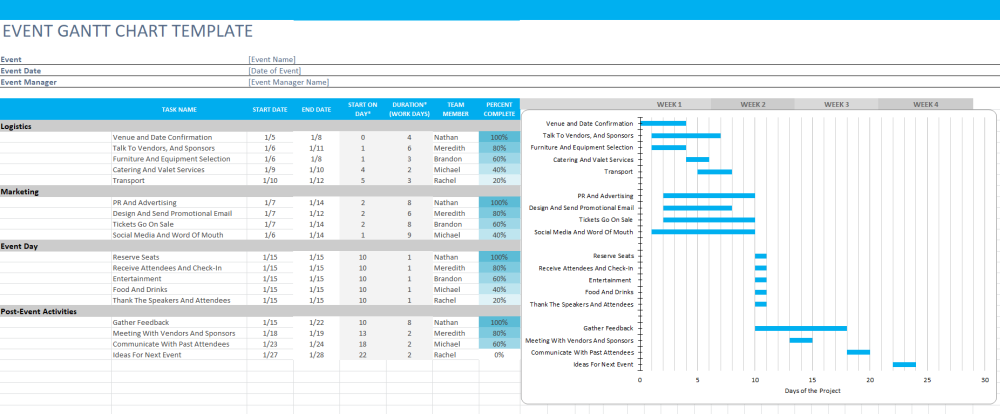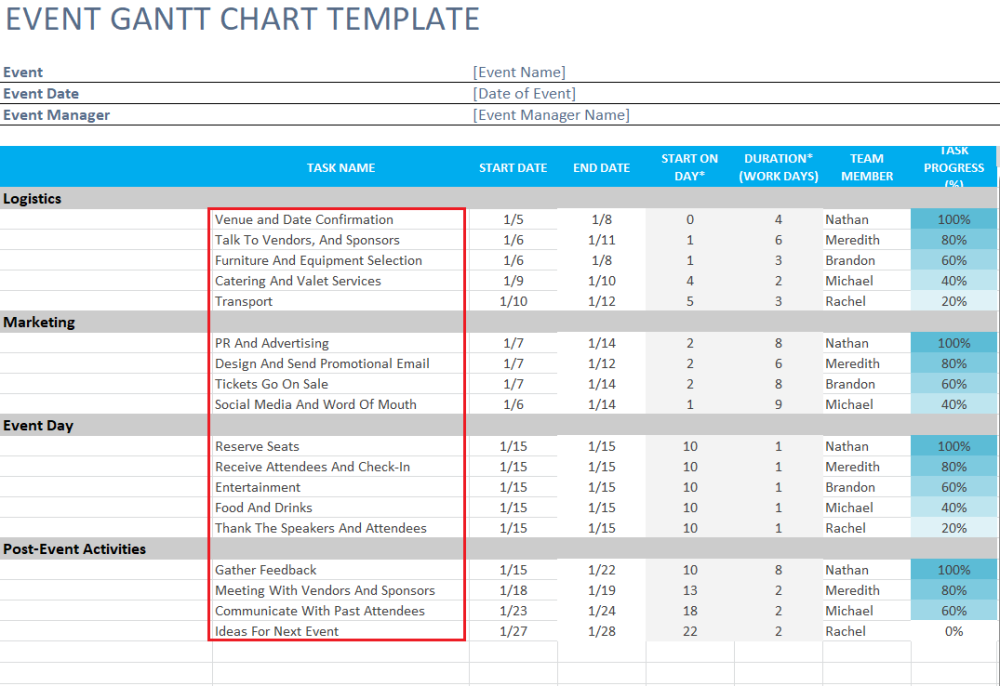
If you are an event planner or event organizer, you know that it’s a tough job to keep track of all of the various event management tasks and to stay organized and on track.
The good news is that you can use event planning tools – like Gantt charts – to plan out events, assign tasks to team members, get a high-level view of the different event planning activities, and so much more.
That’s why we’ve created a template and put together this handy guide to help you create your own personal event Gantt chart. And, in this article, we’ll show you exactly how to use the event Gantt chart template to plan out your next event. Before we begin, let’s quickly take a look at what a Gantt chart is and what you can do with it.
Article Outline
What Is a Gantt Chart?
Professional event organizers use Gantt charts to plan out and visualize the different activities involved with organizing an event. In addition to this, they can set the start and end date for events, set durations for individual tasks, assign team members, and keep track of task progress.

In the context of event planning, a Gantt chart typically includes columns that indicate the different tasks (and their attributes) and a visual graph that shows those tasks displayed against a timeline. In other words, the position and length of the bars reflect the start and end dates of individual tasks.
This way, event organizers are able to see the following information related to event planning at a glance:
- The different activities and tasks they need to perform to organize the event.
- When each task begins and ends i.e. the start and end date.
- How long each task is expected to last.
- Which tasks overlap with other tasks and for how long.
- All event tasks and activities from the start to end of the event.
Simply put, an event Gantt chart gives you a comprehensive view of the entire event planning project.
Gantt charts can be used to plan all sorts of events. These include workshops, fundraisers, conferences, golf tournaments, and seminars, and more. Regardless of the type of event you’re organizing, your team size, or the different activities involved with event planning, you can use an event Gantt chart to better plan and organize your next event.
Why Do You Need a Gantt Chart for Planning Your Event?
An event Gantt chart makes it easy for event organizers to keep track of the different activities connected to planning events.
Whether you need to find a venue, set up online registrations, sell tickets, enlist vendors, come up with a lunch menu, or gather feedback from attendees after your event, you can use an event Gantt chart to easily keep track of your entire event planning project. As a result, you can rest assured that nothing slips through the cracks before the day of the event.
With an event Gantt chart, you’ll be able to easily work out the duration of each task and see which tasks overlap with other tasks. This makes it easy to manage team members and volunteers so that one person isn’t in-charge of multiple activities that happen at the same time.
For example, if Volunteer A is in-charge of checking in attendees on the day of the event, they shouldn’t also be in-charge of making sure guest speakers have everything they need for their presentation.
With a Gantt chart, you’re able to identify any potential shortcomings in your event planning efforts and take action well ahead of time. Following our example, you’d be able to assign Volunteer B to make sure guest speakers are prepared while Volunteer A is tasked to check-in attendees.
Getting Started With the Event Gantt Chart Template
Getting started with event Gantt charts is incredibly easy. All you have to do is …
-
- Add activities and tasks and
- Input their corresponding start/end dates and durations
… and you’ll have your own personal event planning tool!
Before we dive further into the event Gantt chart modification process, let’s quickly take a look at some of the different activities involved with almost all events.
Activities
While the specific activities involved with organizing an event vary from one event to the next, there is some common ground.
-
- Logistics. These are all the event planning related tasks that event organizers generally start out with. Typically this includes finding a venue and setting a date for the event and getting in touch with vendors and sponsors.
- Marketing. Once the logistics are taken care of, event organizers begin promoting their event. Depending on the type of your event you’re organizing and your target audience, this could involve search engine marketing, promoting your event on social media (like Twitter and Pinterest), sending out invites to past attendees, and announcing when tickets go on sale.
- Event Day. On the day of the event, you’ll need to make sure seats are reserved for VIPs, speakers have everything they need to give their presentations, check-in attendees, and make sure entertainment is taken care of.
- Post-Event Activities. After the event, you might consider preparing for and planning out your next event by gathering feedback from attendees and volunteers, meeting with vendors and sponsors, and coming up with new ideas based on the feedback you receive.
How to Get Started With the Event Gantt Chart Template
To get started, download the free, dynamic event Gantt Chart template and follow the steps outlined below to customize it for your own event.
Click here to download your free Gantt chart Event Planner template!
We’ve created a generic event Gantt chart so that you’re able to easily replace activities, tasks, start and end dates, task durations, team members, and task progress with your own. Remember, the main goal of using an event Gantt chart is to be able to view important event planning related information at a glance.
Here’s what you need to do to customize the event Gantt chart to fit your specific requirements:
1. List all the individual activities you’ll need to perform to plan your event. For example, this might include logistics, event marketing, event day, and post-event activities.

2. Split each individual activity into smaller, actionable tasks. For example, you might list tasks like finding an event venue and getting in touch with vendors under Logistics.

3. Once you have activities and tasks in place, assign start and end dates and durations to each task. Once you change the Duration of a task, it’ll automatically be reflected in the Gantt chart view to the right.

4. Our Gantt chart is pre-configured to help you get an idea of which tasks have been completed, which ones are in progress, and which ones haven’t been started yet. We’ve done this by filling in the Task Progress column with different shades of blue. (Dark blue = task is complete, light blue = task is in progress, and white = task hasn’t yet been started.)

5. Finally, assign team members and volunteers to individual tasks. This allows you to see who’s in-charge of what at a glance.

By the time you’re done, your event Gantt chart should look something like this:

Conclusion
Planning an event is by no means easy given the number of activities, tasks, and team members you need to keep track of. Thankfully, with the right tools, you can plan out your event while keeping things organized.
With our custom event Gantt chart, you’ll be able to keep track of which activities and tasks you need to perform before, during, and after the event, assign team members to individual tasks, and set task durations. In addition to this, you’ll also be able to see all of this information at a glance allowing you to stay on top of event planning.
Click here to download your free Gantt chart Event Planner template!
View even more tools to help with your event management tasks!
What are some of the event planning tools you use to plan and organize your events? Let us know by commenting below.